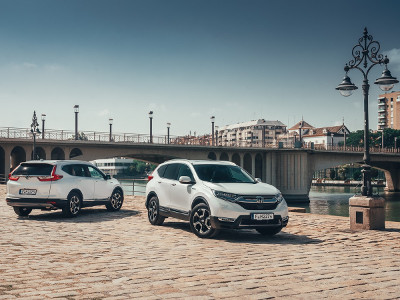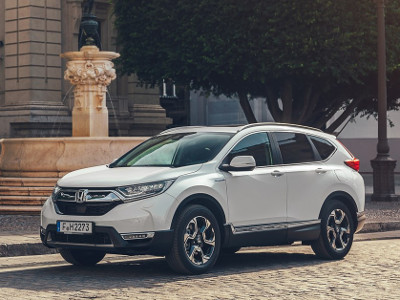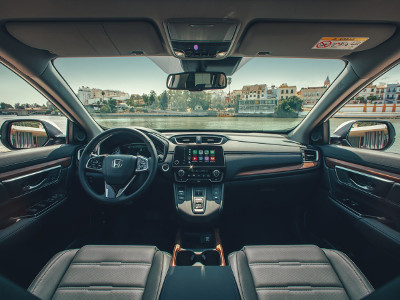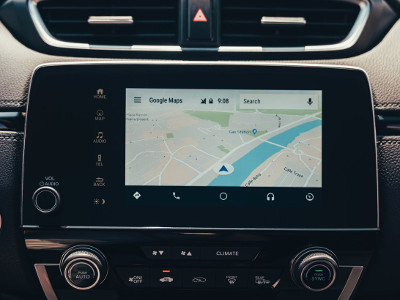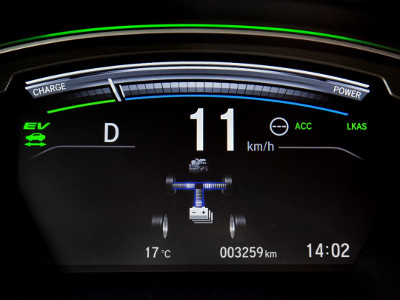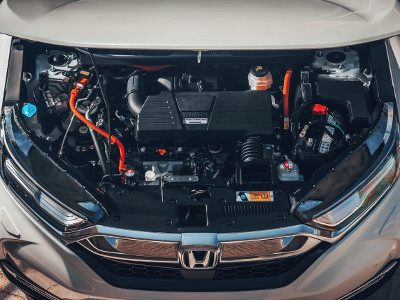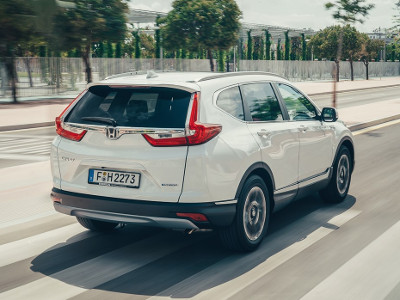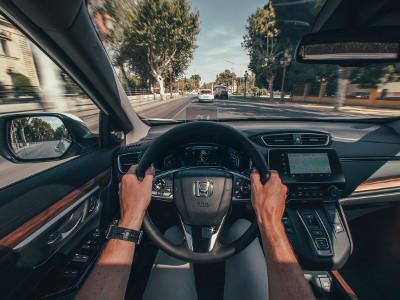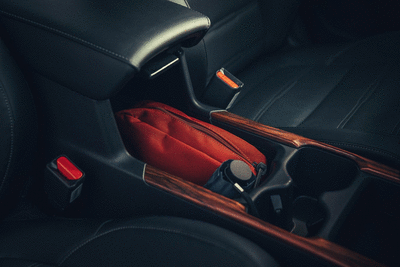Honda CR-V Hybrid
Contents
- Sophisticated and sporty exterior design, with a familiar silhouette and premium-quality interior
- Honda Hybrid Performance brings new levels of refinement, responsiveness and efficiency
- The most sophisticated CR-V chassis ever, with engaging dynamics and exemplary ride comfort
- Improved technologies enhance CR-V's real-world AWD performance and off-road ability
- Class-leading space efficiency in the largest CR-V cabin ever
- Industry-leading safety performance and Honda SENSING as standard
- Video
- Technical specifications
- Further information
Since the introduction of the first-generation model in 1995, the Honda CR-V has continuously improved throughout each generation. In a first for a Honda SUV in Europe, the all-new Honda CR-V will be available with advanced hybrid powertrain technology.
The new model raises the bar in terms of interior quality, sophistication and spaciousness. It delivers improved ride quality, steering response, body control and NVH management. Evolved in every way, the all-new CR-V delivers more comfort, convenience and connectivity than ever before.
The all-new CR-V's slightly larger exterior proportions, longer wheelbase and wider stance enable a significantly larger interior. Best-in-class space efficiency is highlighted by the generous space available for all occupants, as well as a wider, deeper boot with a longer load bay. A hands-free power tailgate enables convenient loading access.
The platform design incorporates Honda's exclusive next-generation ACE™ (Advanced Compatibility Engineering) body structure, which employs a network of connected structural elements to distribute crash energy more evenly. In addition, standard across the range is Honda SENSING, among the most comprehensive suites of active safety and driver-assistive technologies in the class, combining radar and camera information to assist the driver.
Sophisticated and sporty exterior design, with a familiar silhouette and premium-quality interior
The all-new Honda CR-V retains the familiar silhouette, with an evolutionary design that is sophisticated and sporty. The new CR-V has a fresh exterior design, with broader wheel arches and sharper contours on the bonnet and rear quarters, as well as the latest Honda signature headlight graphic.
One of the fundamental changes made by engineers was to extend the length of the wheelbase by 30mm. This change not only provides more space inside but contributes to the more muscular stance of the SUV, with the wheels now placed closer to each corner. A large wheel-and-tyre combination, coupled with a short rear overhang and dual exhaust tailpipes, enhances the athletic impact of the car.
At the front, a bold design integrates the latest Honda family 'face', including the solid wing graphic and signature headlight shape, with LED illumination as standard. The rear haunches are more heavily contoured compared to the previous generation CR-V, complemented by wider arches over all four wheels. Sharply sculpted LED rear lights flow away from the trailing edge of the shoulder line, then wrap around the rear of the car to create an L-shaped graphic on each side that contains the rear window glass. It is finished by a chrome solid wing bar that runs the width of the tailgate between the lenses.
Customers can choose from eight exterior colours: solid Rallye Red, metallic Lunar Silver, Modern Steel, Cosmic Blue and Premium Crystal Red, and pearlescent Platinum White, Crystal Black and Premium Agate Brown.
All versions of the CR-V Hybrid are equipped with 18-inch alloy wheels, and top-grade cars also feature a panoramic glass sunroof as standard.
Advanced aerodynamics
The all-new Honda CR-V is one of the most aerodynamically efficient vehicle in its class1 and was developed with a combination of computational fluid dynamics, scale-model wind-tunnel testing, and Honda's first full-scale wind-tunnel testing incorporating a running belt.
A sleek roofline, featuring a fin-type antenna, is complemented by under-engine and under-floor covers that enable a smooth flow of air above and beneath the CR-V, which reduces drag and improves stability. An overall reduction in aerodynamic drag compared to the previous CR-V also reduces the booming effect from body panels and extrusions, thus benefiting both fuel efficiency and interior quietness.
Air inlets at the front, beneath the chrome Honda badge on the nose, feature Honda's Active Shutter Grille system to improve fuel efficiency. By default, the system keeps the grille shutters closed as much as possible, even in city driving, to improve the aerodynamic performance. However, when required, the system operates an electronic step motor to open the grille shutters as much as necessary to allow airflow into the engine bay. A central processor tracks major temperature parameters for engine coolant, transmission oil and air-conditioning requirements, to determine the ideal state for the shutters.
Premium quality interior
Sleek design conveys a sense of strength and solidity, while highly tactile materials reinforce the premium ambience. An expansive and intricately-stitched soft-touch panel sweeps across the width of the cabin. Honda has increased the space in the front footwells by raising the lowest parts of the dashboard.
Smooth and sophisticated wood-effect trim on the doors and lower dashboard, provides a dash of natural colour. Lustrous metallic trim embellishes the air vent bezels, steering wheel trim, door handles and the climate control panel, adding a contemporary finish. Premium seat upholstery is plush black fabric as standard, while high-quality supple leather is available in a choice of black or ivory for upper grade models.
Honda has rationalised the screen layout, now featuring just one central touchscreen in addition to the 7-inch Driver Information Interface (DII) visible through the steering wheel. The control knob layout has also been simplified, including a simple cluster for air-conditioning management located beneath the touchscreen.
The new CR-V benefits from class-leading forward visibility by using ultra high-strength steel in the forward pillars, enabling them to be 10mm thinner. The view of the road from over the bonnet has also been improved.
Hybrid system controls
The drive selector controls for the new Honda CR-V Hybrid are positioned in the centre console, with a design that uses a compact switch-style transmission selector rather than a conventional lever. Drive, Park and Neutral functions require a button push, while Reverse requires a pull-up action. A bespoke 'Sport' mode, which can be activated via the drive selector, enables a more responsive throttle input for the hybrid system.
If there is sufficient charge in the battery, a short-range pure EV mode is also available at the touch of a button, providing a zero-emissions range of around 2 km (1.2 miles) depending on the driving conditions and battery charge.
Full smartphone integration
The second-generation Honda Connect software in the new CR-V offers enhanced intuitive operation and full, seamless smartphone integration via both Apple CarPlay and Android Auto.
Integration with Apple CarPlay means that Honda Connect now brings iPhone functionality to the driving experience, delivering the interface through the CR-V's built-in display. Drivers can get directions, make calls, send and receive messages, and listen to music from the touchscreen or by voice using Apple's Siri commands.
Android Auto has been designed to give drivers a simple, intuitive way to use Android smartphones through both touch and voice interfaces, minimising the potential for distraction. Supported features include Google Maps, Google Now, messaging, music and numerous other popular apps, depending on the market.
Driver Information Interface
Ahead of the steering wheel sits an all-new instrument binnacle, featuring a large full-colour 7-inch TFT-LCD Driver Information Interface (DII) central display, flanked by battery charge status and fuel-level gauges on the hybrid models.
The CR-V Hybrid's DII includes a large digital speedometer and linear power gauge with a charge status indicator. Integrated into the lower half of the DII is a 'content zone', which the driver can scroll through to choose from a variety of information, including navigation instructions, audio track information, smartphone contacts, all-wheel-drive system status, and smart vehicle maintenance information. For CR-V Hybrid, it also features a graphic of the current power flow, indicating the vehicles power source and if the battery is being charged, and an 'ECO Guide' to suggest more efficient driving techniques In addition drivers can monitor their efficiency over time with a drive cycle score, earning points depicted by leaf icons in the display, increasing or decreasing as a different stage of fuel economy is achieved.
Scrolling and selecting the information to display in the DII is performed via thumbpad controls on the left spoke of the steering wheel. It gives the driver the capability to scroll through the DII modes and adjust settings, perform alphabetic searches - of contacts or music tracks, for example - as well as select the preferred information to display in the instrument binnacle's DII. Also on the left spoke of the steering wheel are the integrated Bluetooth®3 HandsFreeLink® telephone controls. The combination of thumbpad controls and DII display in the driver's forward line-of-sight helps to minimise distractions while underway.
A second thumbpad on the right spoke of the steering wheel operates the adaptive cruise control and lane keeping assist system settings.
Honda Hybrid Performance brings new levels of refinement, responsiveness and efficiency
In a first for a Honda SUV in Europe, the all-new Honda CR-V is available with advanced hybrid powertrain technology. The Honda Hybrid Performance system is enabled by Intelligent Multi-Mode Drive (i-MMD) technology, comprising two electric motors, a power control unit, an Atkinson-cycle petrol engine, lithium-ion battery and an innovative fixed gear transmission delivering high levels of refinement, responsiveness and efficiency.
The CR-V Hybrid is equipped with an efficient 2.0-litre i-VTEC Atkinson-cycle petrol engine, with peak power of 107 kW (145 PS) at 6,200 rpm, and a powerful 135 kW (184 PS) electric motor with torque of 315 Nm. The petrol-electric powertrain can propel the CR-V Hybrid from zero to 100 km/h in 8.8 seconds in FWD guise, and in 9.2 seconds for the AWD model. The top speed of the hybrid is 180 km/h (112 mph).
The front-wheel drive CR-V Hybrid has achieved CO2 emissions of 120 g/km (correlated NEDC2) , with official average fuel economy of 5.3 l/100km (53.3 mpg). The four-wheel drive CR-V Hybrid achieved CO2 emissions of 126 g/km (correlated NEDC[2]) and average fuel economy of 5.5 l/100km (51.4mpg).
Intelligent driving modes
Honda's unique i-MMD technology is so-named as it intelligently and automatically switches between three driving modes to provide the highest possible efficiency when driving. These modes comprise: EV Drive, where the lithium-ion battery supplies power to the electric propulsion motor directly; Hybrid Drive, where the engine supplies power to an electric generator motor, which in turn supplies it to the electric propulsion motor; and Engine Drive, where the engine is connected directly to the wheels via a lock-up clutch.
In most urban driving situations, the CR-V Hybrid will shuffle between Hybrid Drive and EV Drive for optimum efficiency. In Hybrid Drive, excess power from the petrol engine can also be diverted to recharge the battery via the generator motor. EV Drive permits pure-electric propulsion and gives the CR-V a zero-emissions range of around 2 km (1.2 miles) depending on the driving condition and battery charge. The Engine Drive mode is the most efficient set-up for cruising at higher speeds and it can be supplemented by an on-demand power 'boost' from the electric propulsion motor to supplement engine torque under certain conditions
At a 60 km/h cruise, the CR-V Hybrid will typically run in EV Drive for more than half of the time. At 100 km/h, it will be in EV Drive for approximately one third of the time.
To reach maximum speed the CR-V Hybrid will run in Hybrid Drive.
The software 'brain' of the i-MMD system decides when to shuffle between these modes to maximise efficiency, without disturbing the driver or requiring any further thought or input from them.
The 2.0-litre engine, propulsion motor, generator motor and power control unit are located under the bonnet, while the lithium-ion battery pack is housed under the boot.
Innovative fixed-gear transmission
Rather than using a conventional transmission, a single fixed-gear ratio creates a direct connection between moving components, resulting in a smoother transfer of torque. This format means Honda's system is more compact than a planetary eCVT typically found in other hybrid vehicles, as well as being more refined.
Engineers on the CR-V Hybrid programme have worked hard to ensure that the transfer between power sources - including the engine stop-start function - is virtually imperceptible to the occupants. The smooth transfer of torque means there is no driveline shunt or undesirable feedback through the pedals or steering wheel, and the near-silent powertrain means the CR-V Hybrid boasts outstanding NVH management.
The fixed-gear format of Honda's i-MMD system has been specifically tuned for the European market to provide a linear feel through acceleration, with optimised calibration between throttle input and powertrain response, to ensure the engine sound matches the driver's expectations. In addition, the first application of Active Sound Control to CR-V also enriches the drivers experience delivering the natural sound of acceleration relative to the engine speed.
Deceleration Paddle Selector system
The CR-V Hybrid is equipped with a Deceleration Paddle Selector system, which allows the driver to adjust the car's rate of deceleration using paddles behind the steering wheel. By pulling back the paddle on the left side of the steering wheel (indicated by a minus symbol), the rate of deceleration is increased, slowing down the car more quickly. By pulling back the paddle on the right side of the steering wheel, the driver can decrease the rate of deceleration slowing down the car more gently. Regenerative braking is utilised throughout the deceleration stage.
In normal driving, manual adjustment to the rate of deceleration is temporary, and will automatically cancel when driving at a constant speed or accelerating. When the car is in Sport mode, the manually-selected rate of deceleration will be held until it is cancelled by the driver.
The most sophisticated CR-V chassis ever, with engaging dynamics and exemplary ride comfort
The all-new CR-V is based on Honda's latest chassis design, which is the most sophisticated ever engineered for a CR-V and ensures the car delivers exceptional refinement, an engaging driving experience and exemplary ride comfort.
The lightweight and rigid construction features a low centre of gravity, with sophisticated front and rear suspension systems, new control technologies, and new variable-ratio steering. Honda's latest all-wheel drive technology - the 'Real Time AWD with Intelligent Control System™' - together with increased ground clearance, gives the CR-V Hybrid genuine all-terrain capability.
A low-inertia and highly rigid platform is enabled through new body construction that uses lightweight, high-tensile materials that are among the most advanced in the industry. Honda worked closely with a supplier of a new generation of ultra-high strength hot-stamped steel, which increases strength and reduces the overall weight of the entire body frame. Use of hot-stamp ultra-high strength steel increases from 0% in the previous CR-V to nearly 9% in the all-new model. The combined use of high-strength 780 MPa, 980 MPa and 1500 MPa steel is 36% in the new CR-V, compared to 9% on the previous car.
Advanced new unibody
Superior materials and sophisticated engineering processes underpin the CR-V's new platform design, and have helped to create a chassis that is lighter than the previous CR-V, with a 25% increase in torsional stiffness. The rigidity of the unibody contributes significantly to the car's impressive NVH characteristics.
The body assembly process also involves an innovative high-efficiency joining technique, which contributes greatly to the overall stiffness of the body. Short-pitch welding further contributes to increased stiffness and durability.
These design, engineering and manufacturing innovations result in a 35% increase in the body's global bending rigidity compared to the previous generation CR-V, and a 25% increase in torsional rigidity. This in turn provides a greater opportunity to tune the suspension for superior ride and handling performance, and helps to safeguard European standards of quality and refinement.
Class-leading interior refinement
The all-new platform contributes to class-leading interior quietness and refinement, which complements the CR-V's petrol-electric hybrid powertrain. The CR-V Hybrid has been tuned with a keener focus on making the driving experience as quiet, comfortable and refined as possible.
Minimised generation of engine noise is aided by the first application of Active Noise Cancellation (ANC) in a CR-V, which is standard across the range. ANC uses two in-cabin microphones to monitor for noises from the powertrain and can then create precisely timed 'reverse phase' audio signals to cancel them out.
Powertrain noise is further mitigated by dedicated front, side and rear bonnet seals, a bonnet insulator panel, an engine under-cover, wheel-arch under-covers, dedicated insulation material within the dashboard, a one-piece carpet liner, body and window sealants, acoustic separators inside the door pillars, and the flush-mounted windscreen, all contribute to the overall cabin quietness. Lastly, the large body panels are shaped using computer aided engineering (CAE) with a specific goal of reducing booming noise.
Rewarding dynamics and exemplary comfort
All-new suspension and a boost in body rigidity contribute to the most engaging and sophisticated driving experience ever found with a CR-V. A wider body stance and longer wheelbase contribute to improved stability, complemented by a larger wheel and tyre size combination and an increase of 27mm in ground clearance for the hybrid version.
Vibration transfer to the steering wheel is minimised by increasing the steering column diameter to 30 mm - 36% wider than on the previous CR-V - and locating the lightweight steering motor on the dual pinion rack, rather than on the steering column. Low-speed manoeuvrability has improved, with a 26% reduction in lock-to-lock measurement, down to 2.3 turns.
At the rear, an all-new rear multi-link suspension set-up delivers increased geometrical stability for predictable high-speed driving, superior ride comfort and more linear handling in conjunction with the EPS tuning. A solid rear stabiliser bar sharpens turn-in and reduces body roll, while a new floating, rubber-mounted, subframe structure improves noise isolation over the previous CR-V.
Hydraulic suspension bushings, normally reserved for luxury-class vehicles, are fitted at the front and rear, resulting in superior ride isolation as well as enhanced chassis vibration control.
Larger brakes are fitted to all four wheels and are enhanced by the addition of an electric brake booster (EBB), delivering class-leading braking performance and feel. The EBB calibrates braking performance to vehicle speed and driver input, and can build up superior hydraulic pressure more quickly and with less pedal effort in all braking situations compared to conventional systems.
The CR-V Hybrid's i-MMD technology also employs a regenerative braking system to capture energy that would otherwise be lost when the car is decelerating.
Agile Handling Assist (AHA)
Honda's Agile Handling Assist (AHA) is fitted to the CR-V for the first time. The electronic stability system has been specially tuned for the European market to reflect typical road surface conditions and driving styles. It provides subtle, discreet assistance for added safety and smoother, more predictable vehicle behaviour at low and high speeds, and with both gentle and rapid steering inputs.
Improved technologies enhance CR-V's real-world AWD performance and off-road ability
New CR-V's off-road capability is improved, as it offers higher ground clearance than its predecessor with no impact on the centre of gravity.
Clearance underneath the car is increased to 182 mm for front-wheel-drive hybrid models, and to 192 mm for all-wheel-drive hybrid models. Both increases deliver a 27mm higher stance than the previous CR-V. The ground clearance is in part helped by the larger-diameter wheel and tyre combinations, which also convey a more muscular stance.
Honda's latest all-wheel drive technology - the 'Real Time AWD with Intelligent Control System™' - is calibrated to deliver optimum fuel efficiency and driveability. It supports the front axle for smooth and efficient driving, even in everyday conditions, for example through powering the rear wheels when starting from a stop.
Software updates to the AWD system result in the ability to send up to around 60% of torque to the rear wheels when required, as well as an overall increase in torque through the system. The result is improved performance in low-traction conditions, as well as more responsive and capable hill-climbing performance and more dynamic cornering performance.
Class-leading space efficiency in the largest CR-V cabin ever
All occupants are afforded generous space, thanks to a wider stance, a longer wheelbase and a thinner flatter fuel tank. The driver and front passenger benefit from a 5mm increase in headroom and 16mm more hip room compared to the previous-generation CR-V, while second-row passengers gain an additional 50mm of legroom.
Four-way power lumbar support is provided for front seat occupants, which offers 80 mm of vertical adjustment and 35 mm of longitudinal adjustment. Energy-saving, fast-warming heated seats are also available, with heated seat cushions for front and rear occupants, and heated seat backs for the driver and front passenger.
More versatile than ever
The new CR-V features its biggest ever loading bay, with a 160mm increase in width and a maximum loading length of 1,830mm - up 250mm on the previous model, enabling it to accommodate a 19.5-inch frame mountain bike.
New single-action 'dive down' 60:40 split-fold seatbacks enable faster, easier loading, and a completely flat surface for larger items. Dropping either section of the second-row bench seat can be done single-handedly; the seat base lowers towards the floor to enable the rear seatback to lie flat on top of it. The seatback can be 'reset' single-handedly as well.
On top grades, a hands-free power tailgate is available, which also features a height-setting function (for restricted height opening). An on-demand 'Stop-and-hold' function allows the tailgate to be stopped at any desired position, which gives temporary control of the height opening (once opened beyond 1,185mm) without needing to program the setting.
Smarter storage for all occupants
A new three-mode centre console adapts to a variety of requirements. In its 'Console tray' mode, it can accommodate a 5.5-inch smartphone. The tray can be placed in forward or rearward positions or stowed neatly, to enable three storage configurations. In the forward position, the smartphone tray covers up the main storage compartment for added security and privacy. When placed rearward, the tray keeps smaller items separated while enabling access to the compartment below. If the tray is stowed out of the way altogether, the storage compartment is large enough for a handbag or laptop.
Four USB charging points in the cabin enable multiple connections for phones, tablets and other personal electronic devices. There are 1.5-amp and 1.0-amp USB charging ports for front occupants, plus two high-capacity 2.5-amp USB charging ports at the back of the centre console for second-row passengers.
Cabin occupants can make use of extra-large capacity door pockets - 48% longer at front and 63% longer at the rear - enabled by moving speakers further up in door panels compared to the previous CR-V.
Industry-leading safety performance and Honda SENSING as standard
The all-new CR-V has been engineered to achieve industry-leading safety performance. In line with Honda's 'Safety for Everyone' philosophy, the same passive and active safety systems are included across all grades of the new CR-V Hybrid.
The exceptionally strong, rigid and stiff platform provides the foundation for exceptional safety performance, with an 'All Directions Collision Safety' concept. The platform design incorporates Honda's exclusive next-generation ACE™ (Advanced Compatibility Engineering) body structure, which employs a network of connected structural elements to distribute crash energy more evenly. This design helps to reduce the forces transferred to the passenger cell in the event of an impact, giving superior front, side and rear crash-worthiness.
The passive safety features on the all-new CR-V are complemented by the Honda SENSING suite of active safety and driver assist technologies, which - in a first for Honda - is installed on all CR-V grades. Honda SENSING uses a combination of radar and camera information, plus a host of high-tech sensors to warn and assist the driver in potentially dangerous scenarios. Emergency call (eCall) is now also standard across all grades of the CR-V in Europe.
The Honda SENSING suite of active safety technologies includes:
- Collision Mitigation Braking System: helps to bring the car to a stop if the system determines that a collision with a vehicle detected in front is unavoidable. A warning sounds, and if necessary, brake pressure is automatically applied
- Forward Collision Warning: scans the road ahead to warn drivers of a potential collision, and provides visual and audible alerts to prompt the driver to take corrective actions to avoid a crash
- Lane Departure Warning: will detect if the car is straying out of its current lane without the turn signal being activated, and provides an alert to prompt the driver to make a correction
- Road Departure Mitigation: uses data from the windscreen-mounted camera to detect whether the car is veering out of its lane. It uses the Electric Power Steering to apply subtle corrections to keep the vehicle in its lane, and in certain situations can also apply braking force. The system switches off when it detects that the driver has regained control
- Lane Keeping Assist System: helps to keep the car in the middle of the current lane, by detecting road markings with a monocular camera and making small adjustments to steer the vehicle within the white lines.
- Adaptive Cruise Control: allows the driver to set a desired speed and following distance from a vehicle detected ahead, which enables the use of cruise control in light, variable-speed traffic conditions
- Traffic Sign Recognition: detects and automatically recognises road signs and displays the signs on the instrument binnacle's IID
- Intelligent Speed Assistance: combines the automatic speed limit set by the driver with TSR to automatically adjust the vehicle speed to that indicated by the last road sign
- Intelligent Adaptive Cruise Control: a pioneering technology that debuted on the 2015 Honda CR-V, i-ACC predicts and automatically reacts to other vehicles 'cutting-in' on multi-lane highways. It uses a camera and a radar to sense the position of other vehicles on the road and applies an algorithm - developed with exhaustive research on European roads - to predict the likelihood of vehicles in neighbouring lanes 'cutting-in'. This enables the new CR-V to adjust its speed automatically before other vehicles cut in, for a safe and comfortable journey.
Further safety technologies in the all-new CR-V include:
- Blind Spot Information: uses radar technology to automatically detect vehicles in the driver's blind spot and alerts the driver via a warning symbol in the door mirror
- Cross Traffic Monitor: uses rear side radar sensors to warn the driver of approaching vehicles when reversing
- Multi-angle rear view camera: provides the driver with options for complete visibility and therefore peace-of-mind when reversing; a normal 130-degree view, a wide 180-degree view and a top-down view
Also fitted as standard are Vehicle Stability Assist (VSA®) with traction control, which enhances control capability while the vehicle is accelerating, braking, cornering, and Deflation Warning System for tyres
Video
Technical specifications
- All technical information is preliminary and subject to change
- Vehicle emissions are certified with the new type approval procedure WLTP in accordance with Commission Regulation (EU) 2017/1151. The referred values are NEDC values determined via the correlation procedure of Commission Regulation (EU) 2017/1153.
| ENGINE/MOTOR | Unit | 2.0-litre i-VTEC HYBRID |
|---|---|---|
| Bore x stroke | mm | 81.0 x 96.7 |
| Capacity | cc | 1993 |
| Compression ratio | 13 | |
| Max. power (Engine) | kW / PS | 107 kW / 145 PS |
| @ rpm | 6,200 rpm | |
| Max. power (Motor) | kW / PS | 135 kW / 184 PS |
| Max. power (Total) | kW / PS | 135 kW / 184 PS |
| Max. torque (Engine) | Nm / lb ft | 175 Nm / 129 lb ft |
| @ rpm | 4,000 rpm | |
| Max. torque (Motor) | Nm / lb ft | 315 Nm / 232 lb ft |
| Fuel rating | Unleaded 95 |
| STEERING/SUSPENSION | 2.0-litre i-VTEC HYBRID |
|---|---|
| SUSPENSION | |
| Front | MacPherson strut |
| Rear | Multi-Link |
| BRAKES | |
| Front | Ventilated disc |
| Rear | Solid disc |
| STEERING | |
| Type | Dual Rack and Pinion Electric Power Steering |
| Turns lock to lock | 2.34 |
| Turning circle (at wheels) | 11 |
| Turning circle (at body) | 11.9 TBD |
| WHEELS AND TYRES | |
| Wheels | 18" Alloy Wheels |
| Tyres | Tyres 235/60R18 |
| DIMENSIONS, WEIGHTS, CAPACITIES | Unit | 2.0-litre i-VTEC HYBRID FWD | 2.0-litre i-VTEC HYBRID AWD |
|---|---|---|---|
| Overall length | mm | 4,600 | 4,600 |
| Overall width (with door mirrors) | mm | 2,117.20 | 2,117.20 |
| Overall height | mm | 1679 | 1689 |
| Wheelbase | mm | 2663 | 2662 |
| Ground clearance | mm | 182 | 192 |
| Luggage space (VDA method; seats folded, to roof) | litres | 1694 | 1694 (1638 with Glass roof) |
| Luggage space (VDA method; seats folded, to glass) | litres | 1064 | 1064 |
| Luggage space (VDA method; all seats up) | litres | 497 | 497 |
| Kerb weight | kg | 1614-1657 | 1672-1726 |
| Max. permitted weight | kg | 2240 | 2275 |
| Towing capacity (braked) | kg | 750 kg | 750 kg |
| Towing capacity (unbraked) | kg | 600 kg | 600 kg |
| Fuel tank capacity | litres | 57 | 57 |
| PERFORMANCE | 2.0-litre i-VTEC Hybrid FWD | 2.0-litre i-VTEC Hybrid AWD |
|---|---|---|
| Top Speed km/h | 180 | 180 |
| Acceleration 0-100 km/h | 8.8 | 9.2 |
| CO2 EMISSIONS & FUEL CONSUMPTION[2] | Units | 2.0-litre i-VTEC i-MMD Hybrid FWD | 2.0-litre i-VTEC i-MMD Hybrid AWD |
|---|---|---|---|
| Urban CO2 | g/km | 113 | 117 |
| Extra Urban CO2 | g/km | 124 | 131 |
| Combined CO2 | g/km | 120 | 126 |
| Urban fuel economy | l/100km (mpg) | 5 (56.5) | 5.1 (55.4) |
| Extra Urban fuel economy | l/100km (mpg) | 5.4 (52.3) | 5.7 (49.6) |
| Combined fuel economy | l/100km (mpg) | 5.3 (53.3) | 5.5 (51.4) |
